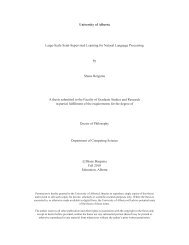The high altitude wildlife areas of western Arunachal Pradesh
The high altitude wildlife areas of western Arunachal Pradesh
The high altitude wildlife areas of western Arunachal Pradesh
Create successful ePaper yourself
Turn your PDF publications into a flip-book with our unique Google optimized e-Paper software.
Appendix 2<br />
individuals <strong>of</strong> the Tawang macaque had a prominent pale-yellow patch on the<br />
otherwise dark crown. <strong>The</strong> Assamese macaque, in contrast, has much lighter facial<br />
skin and a golden brown coat with plain buff-coloured or whitish hairs ventrally. <strong>The</strong><br />
undersurface in the Assamese macaque is relatively very sparsely haired, with the pale<br />
bluish skin showing through 1 . Further, most Assamese macaque individuals have a<br />
smooth crown hair arrangement (with an occasional central parting), although some<br />
individuals do have a whorl or tuft <strong>of</strong> hair in that position 1 (A. Sinha pers.obs.).<br />
<strong>The</strong> two subspecies <strong>of</strong> the Assamese macaque are morphologically<br />
distinguished from each other only by relative length <strong>of</strong> their tails 1 (ratio <strong>of</strong> tail length<br />
to head-body length). In M. a. assamensis, relative tail length <strong>of</strong> adult males ranges<br />
from 0.26 to 0.44, and in M. a. pelops from 0.50 to 0.69. In this regard, the observed<br />
relative tail length <strong>of</strong> the Tawang macaque males overlaps with that <strong>of</strong> M. a.<br />
assamensis. Interestingly however, looking at the distribution <strong>of</strong> the Assamese<br />
macaque, the Tawang macaque should be sympatric with M. a. pelops (which has a<br />
significantly larger relative tail length) that occurs in central Nepal, eastward through<br />
Sikkim, northern West Bengal, central Bhutan, and probably <strong>western</strong> <strong>Arunachal</strong><br />
<strong>Pradesh</strong> 1 . On the other hand, the M. a. assamensis, whose relative tail length is similar<br />
to that <strong>of</strong> the Tawang macaque, occurs within India in eastern <strong>Arunachal</strong> <strong>Pradesh</strong>,<br />
Nagaland and Assam 1,2 , and is not expected to be sympatric with the Tawang<br />
macaque.<br />
We did not sight any Assamese macaque in Tawang or West Kameng during<br />
our expedition. <strong>The</strong> species is largely restricted to a relatively narrow altitudinal zone<br />
between 150 and 1900 m asl (although the maximum record for one troop 1 is 2750 m).<br />
Thus, the striking morphological differences and the altitudinal specificity <strong>of</strong> their<br />
distributions make it improbable that the Tawang macaque is a subspecies <strong>of</strong> M.<br />
assamensis.<br />
Comparison with the Tibetan macaque<br />
<strong>The</strong> Tibetan macaque is distributed principally in east-central China, at <strong>altitude</strong>s <strong>of</strong><br />
1000-2500 m, south to the Guangxi Province and west to the Yangtze Gorge in<br />
<strong>western</strong> and north-<strong>western</strong> Szechuan Province. <strong>The</strong> only report <strong>of</strong> the macaque<br />
outside this distributional range is that <strong>of</strong> Choudhury in the West Kameng district <strong>of</strong><br />
<strong>Arunachal</strong> 3 (see later).<br />
<strong>The</strong>re are some similarities between the Tawang macaque and Tibetan<br />
macaque in terms <strong>of</strong> morphology and altitudinal distribution. <strong>The</strong>se include the large<br />
and heavy built <strong>of</strong> the Tibetan macaque, its dark brown coat, a relatively hirsute<br />
underside, and the occasional small whorl on the vertex <strong>of</strong> the crown with short hairs<br />
radiating from it 4 . <strong>The</strong> Tawang macaque, however, differs from the Tibetan macaque<br />
in having a pronouncedly prognathous skull, relatively much darker facial skin, a very<br />
prominent and ubiquitous pale-yellow crown patch, and a significantly longer tail<br />
(relative tail length <strong>of</strong> male Tibetan macaques ranges from 0.07 to 0.09) 4 . Further, the<br />
Tawang macaque lacks a prominent bushy pale buff-coloured beard and full cheek<br />
whiskers found in the Tibetan macaque.<br />
Choudhury 3 reports a troop <strong>of</strong> macaques from an altitudinal range similar to<br />
that <strong>of</strong> the Tawang macaque in the neighbouring West Kameng district. He<br />
38

















